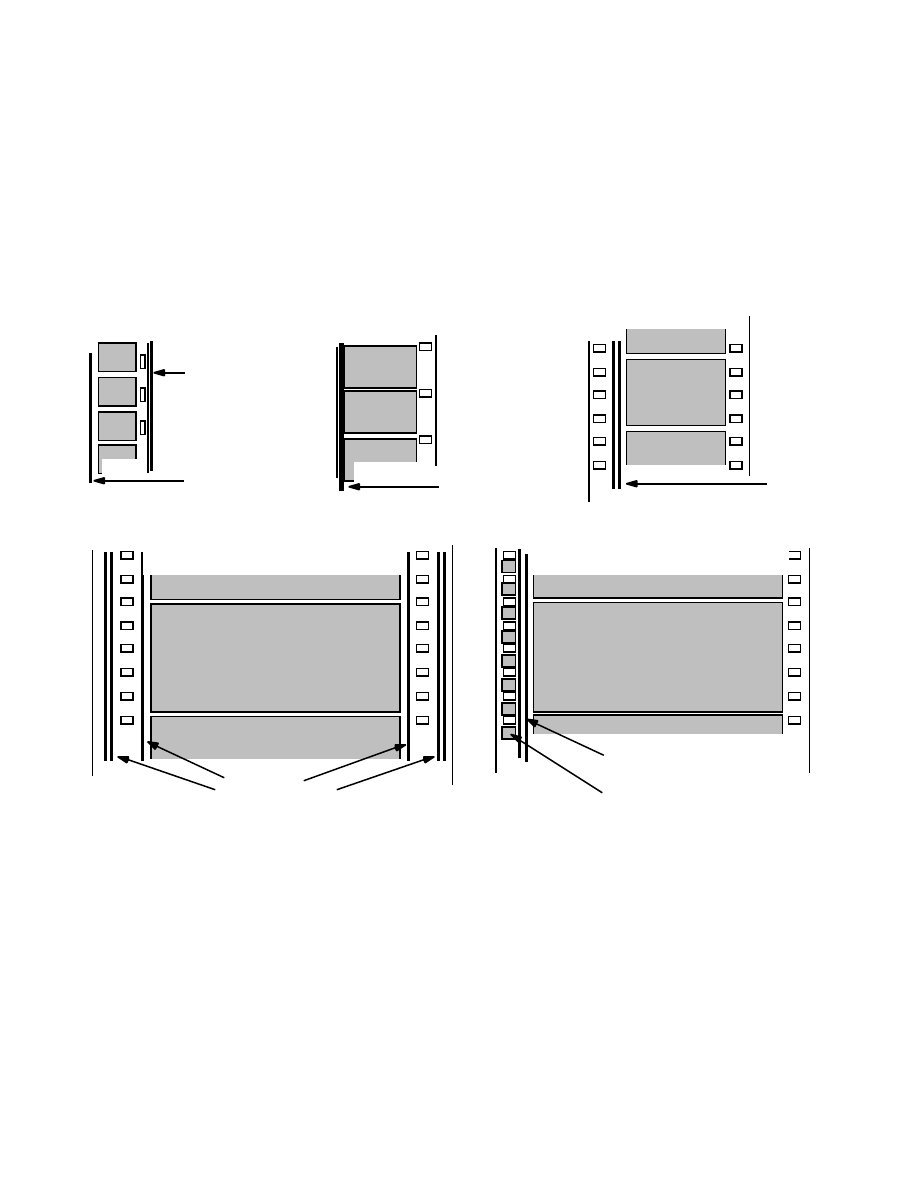ВУЗ: Казахская Национальная Академия Искусств им. Т. Жургенова
Категория: Учебное пособие
Дисциплина: Не указана
Добавлен: 03.02.2019
Просмотров: 12347
Скачиваний: 6

F
film soundtrack: The audio component, including DME, of a film composition. There is
usually a requirement for sound to be synchronized to the video image. This has been
achieved by a variety of means, including the recording of sound on optical tracks etched into
the film emulsion alongside the frames, fixing magnetic tracks on the film surface, synchro-
nizing the film with a separate tape machine by means of mechanical sprockets, and elec-
tronic sync using systems such as SMPTE. See also Dolby Stereo, LC Concept, optical track,
SR.D, pilot tone, layback recorder, source track.
Super 8mm
Magnetic
Sound Track
Balance
Stripe
16mm
Optical or
Magnetic
Sound Track
Optical
Sound
Track(s
)
35mm (Academy)
70mm
Analog
Sound Tracks
Digital
Sound Tracks
Dolby Stereo Digital Print
Magnetic
Sound Tracks
Film Soundtrack Formats
filter: (1) A type of equalizing device for subtractively eliminating selected frequencies from
the sound spectrum of a signal and perhaps, in the case of a resonant filter, increasing the level
of other frequencies. See VCF. For example, a lowpass filter passes lower frequencies and re-
moves the higher frequencies. By raising or lowering the filter rolloff frequency parameter, a
sound will be made brighter or darker. (2) A device or MIDI software filter that eliminates
selected messages from the MIDI data stream, usually called MIDI filtering by data thinning.
See also running status.

F
filter resonance: The greater the resonance on a filter, the greater the effect of the filter: as
resonance control is turned up, a little peak appears at the rolloff frequency. The harmonics
that fall within that peak are accentuated. The greater the resonance, the higher the peak and
the more pronounced is this effect. The effect of the swept resonant peak does not occur in
real instruments. See also Q.
filter scaling: See keyboard scaling.
final mix: The mixing of the final stems, which, when mixed and replayed represent the
film’s finished soundtrack. In a stereo film (or surround-encoded TV programming) it is most
common to record the DME stems on three pieces of 4- or 6-track magnetic film, with Dolby-
SR noise reduction, or on analog or digital multitrack tape, or onto a digital dubber. These
stems, also known as dub masters, are then used to create the print masters, the M&E mix, a
mono mix, and possibly an airline version. For a non-surround-encoded stereo mix, then the
stems might be in standard stereo format, but this precludes the subsequent production of a
5.1 mix, say for DTV.
finder: The user interface of the Mac operating system, allowing access to the file system, pe-
ripherals, and other components of the system hardware and software.
fine: The End.
fine cut: A stage in the editing of a film or video production at which the workprint or EDL is
completed, denoting that the production is ready for final cut approval.
FIR: Finite Impulse Response: A class of filter designs whose impulse response falls to zero
in a predictable, finite length of time, as opposed to an IIR (Infinite Impulse Response) design
whose impulse response may never fully attenuate the impulse. A common use of FIR is to
produce filters with a linear phase response. Filters such as analog anti-aliasing filters which
have a very sharp rolloff slope produce unacceptable amounts of phase distortion in the output
signal; FIR filters are used at the end of an oversampling A/D chain to eliminate any signal
that would represent aliasing in the slower output datastream, without causing significant
phase distortion.

F
FireWire: A digital audio transmission medium developed by Apple computer, designed to
support dozens, possibly hundreds, of high-bandwidth audio streams. IEEE 1394 is designed
to replace point-to-point AES/EBU connections, will support multiple data formats so that
audio, video, MIDI, and control signals may all be send over a single cable. FireWire also dis-
tributes power as well as data, permitting hot-plugging of devices. IEEE 1394 is designed to
be a fully specified bus, bi-directional and with the ability to broadcast from a single source
to multiple receivers. Currently (late 1998) there is a 4.5–limit between any two adjacent
nodes, designed to support a simple, low-cost clocking mechanism to be built into the stan-
dard to support isochronous data transfers for audio and video. The isochronous clock em-
bedded within the IEEE 1394 standard runs at 8MHz, or one “tick” every 125µs. This is
problematic for audio signals which require upwards of 44MHz clock rates, so the FireWire
standard is being modified to address the problem of high-resolution synchronization. The
signal can traverse up to a maximum of 16 hops, effectively extending the distance to about
70 meters. This was originally developed to support the transfer of high-bandwidth signals
between computer peripherals; the multi-layer IEEE 1394 standard also allows the use of
many other cabling technologies, including Category 5 twisted pair copper wire and 50mm
multi-mode optical fibre, the later permitting distances between devices of hundreds of me-
ters. See also mLan.
Comparison between SCSI and FireWire
SCSI
Firewire
Number of devices supported
6
63 per segment
Connector size
Large-Medium
Small
Requires termination
Yes
No
Sets device ID automatically
No
Yes
More than one computer per segment
No
Possible
Device-sharing
No
Possible
Hot-pluggable
No
Yes
Topology requirements
Serial
None
Transmission method
Parallel
Isochronous
Computer required for data transfer
Yes
No
Standard Transfer rate
40 Mbps
400 Mbps
Maximum transfer rate
640 Mbps
800 Mbps min.
Maximum network length
12 meters
72 meters
fishing rod: See boom.
fixate: The process whereby a CD’s overall lead-in, program data and lead-out areas are
written. This is done during the track-at-once recording process when the final session is writ-
ten, allowing all of the data contained on the disc to be read by any CD or CD-ROM drive.
fixed formant: A frequency characteristic of a sound, e.g., human vowel sounds are formants
which are relatively fixed in frequency, even though the pitch of the voice may be changing as
in singing. It is the fixed formant frequencies in the presence of the varying pitch of a musi-
cal instrument that shapes the instrument’s timbre and makes the instrument recognizable.

F
flamming: An undesirable audio occurrence in which one of the instruments used on a
rhythm track strikes slightly behind the others. It is caused primarily by the improper appli-
cation of delay or tempo change.
flange: The round metal sides of a tape reel that keep the tape aligned as it winds onto the
hub.
flanging: Named for the original effects technique where a second audio tape playback deck
was slowed by a thumb on the reel flange, flanging is a special audio effect where a delayed
version of a signal is mixed with the original signal, creating a swooshing sound. This is
caused by the fact that when the time delay is different for the two combined signals, there
will be frequencies where the phase-shift is 180˚ and the signals will cancel, causing deep
dips or holes in the frequency response curve called the comb filter effect. As the speed is
varied, the frequency of the dips is swept across the frequency range, giving the swooshing
sound. Electronic flangers contain an adjustable electronic delay line. If the time delay is very
short, the effect is called phasing. See also notch filter.
flat: (1) The condition of a note which is, either deliberately or accidentally, lowered in pitch.
This might be only a few cents or as much as a tone (double flat, ). In music notation, a flat
is indicated by the flat symbol ( ), meaning lower the tone by a half-step. (2) The same as dry.
Unequalized, uncompressed, and otherwise unprocessed, describing a signal from any
source: mic, instrument, or tape playback. (3) The neutral position on a tone control, effecting
no change to the signal. See center detent. (4) Film projection using non-anamorphic lenses.
In the U.S. the term flat is synonymous with an aspect ratio of 1.85:1 widescreen. See
anamorphic.
flat response: The faithful reproduction of the amplitude of an audio signal, specifically,
variations in output level of less than one decibel above or below a median level over the en-
tire audio spectrum. A system which has the same gain at all frequencies of interest will
yield a graph of the gain versus frequency that will be linear.
flattening: A general term for the process of moving the final stems, tracks, etc. to
audio/video tape, usually involving a substantial reduction in the number of tracks on which
the sound is carried and merged with the time-coded video. Also specifically refers to the
process in ProTools™ whereby stereo audio and video is exported to a QuickTime movie or
other format.
flat wind: To employ a slower-than-normal fast forward or rewind mode on a tape transport
in order to wind the tape smoothly and evenly onto the reel or hub, usually for storage. Flat
winding prevents edge curling and other types of deformation damage. See also heads-out.
Fletcher-Munson effect: Fletcher and Munson measured the sensitivity of human hearing at
various volumes and frequencies with the finding that humans hear best in the range of
3kHz-4kHz; the sensitivity falls off rapidly at lower frequencies and somewhat more slowly
at higher frequencies. In other words, very soft sounds must be more powerful at frequen-
cies lower and higher than 3kHz-4kHz in order to be heard. The loudness control on music
reproduction systems was designed to compensate for the Fletcher-Munson effect. See equal
loudness curves.

F
flicker noise: At high frequencies, intrinsic noise is dominated by Johnson noise. At lower fre-
quencies, there exists a critical frequency, ƒ, at which noise rises proportional to
1
f
.
Below
this critical frequency, the noise is called flicker noise. Sometimes referred to as flicker effect.
floating unbalanced output: a
1
4
” phone-type output where the sleeve of the output stage is
not connected inside the unit, and the ring is connected, usually through a small resister, to
the audio signal ground. This allows the tip and ring to “appear” as equal impedance, not-
quite-balanced output stage, even though the output circuitry is unbalanced. Floating
unbalanced often works to drive either a balanced or unbalanced input, depending if a TS or
TRS standard cable is plugged into the output. If a floating unbalanced connection hums, a
ground-lift cable is required. Also known as a pseudo-balanced output, or quasi-balanced.
floor: In a noise gate, the amount of attenuation applied to an input signal whenever it is be-
low the threshold level. For example, in a gate whose threshold is set to -10dBm and whose
floor is set to -30dB, 30dB of attenuation is applied whenever the incoming signal drops be-
low -10dBm.
flutter: (1) In a tape recorder, if the tape speed varies, the pitch of the recorded music will
vary. If the rate of variation is fairly high, typically above 5Hz or so, it is called flutter. If the
speed varies at rates below several Hertz, it is called wow. Flutter is actually a type of fre-
quency modulation distortion and imparts a tremolo- or vibrato-like character to the music. (2)
See chatter.
flutter echo: An acoustic effect where sound is reflected back and forth between two parallel
surfaces such as walls. The same effect as standing waves, but at lower frequencies, flutter
echo is created when reflections are lower than 15Hz, or when walls are greater than 25’
apart.
flux: Lines of force surrounding a magnet. In measuring the strength of a magnetic field at a
particular location, the number of lines of force per unit area in a plane perpendicular to the
direction of the lines. The standard reference unit in magnetic tape for recording is the
nanoweber per meter, and is called flux density.
fluxivity: The numerical measure of maximum flux density a specific type of recording tape
can hold. Reference fluxivity is a standardized amount of flux, specified in nanowebers per
meter, which is laboratory-recorded on a test tape at various frequencies. Such reference tapes
are used to calibrate tape recorder 0dBVU playback levels.
fly in: (1) To mix sounds from a non-sync source into the live sound for a TV show, or into
the mix for a videotape production or spot. One may fly in a narrator, Foley, etc. (2) To re-
cord sections from one or more tracks of a multitrack tape onto a second recorder (generally a
two-track), then copy them back onto the multitrack in another section of the performance.
For example, one might take the background vocals from one chorus and fly them into an-
other section of the song. Short fly-ins can be done without SMPTE sync, although it is
somewhat difficult.
FM sync: The 13.5kHz frequency-modulated sync pulse recorded on Nagra IV-S recorders.